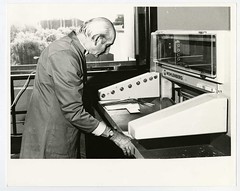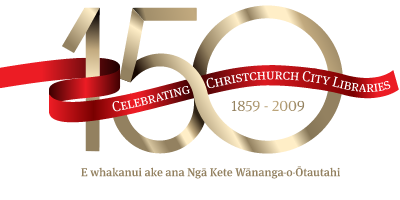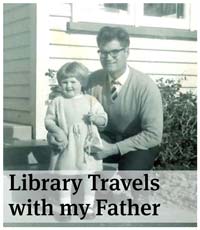Bindery Wahi tuara pukapuka
Christchurch City Libraries has had its own bindery for over 50 years, providing valuable services in maintaining the libraries hard working bookstock. The bindery also provides skilled restoration and repair services to the public.
The first Bindery was established at Canterbury Public Library by the City Librarian, Ron O’Reilly in 1952. A qualified bookbinder, Mervyn Ellis, was appointed in July of that year and by September he had installed the first equipment and started work. At 31 March 1953 there were four staff and 7,592 items had been processed. It was hoped to recruit more staff but this proved difficult because of the competition for people with the requisite skills. The Bindery was originally called the Rebinding Department, showing the emphasis of the work. Very little new material was treated.
At first the Bindery was located in the main library building Cambridge Terrace. By 31 March 1954, the staff had grown to five and the statistics for the 1953/54 period revealed the workload:
- 3,712 volumes were rebound or bound
- 846 volumes were recased in their original cases
- 8,439 magazines were quarter-bound
- 1,795 magazines were quarter bound for suburban community run libraries
 It was planned to purchase a guillotine in the next financial year.
It was planned to purchase a guillotine in the next financial year.
Mervyn Ellis left in April 1960. He was followed by Ron Glanville and then Gerald Visser who was in the position for only a short time before he became ill and died. Don Hampshire was appointed to head the Bindery in 1966 and he remained in the job until his retirement in 1987. Don had learnt his trade in England and had been a bookbinder since 1938. Don will be known to many people in Christchurch for the classes he ran for keen amateur book binders.
New moves for the Bindery
By 1966 the library was growing rapidly and alterations meant the bindery was moved to the ground floor of the Librarian’s house next door, where it remained until the Central Library’s move to Gloucester Street in 1982. In the new library building the bindery occupied an airy corner of the third floor. They were also the proud owners of a brand new guillotine which replaced the 30-year-old model.
David Lawrie took over from Don Hampshire in 1987. Pressure for library space again forced a move to the current location, Smith Street, in November 1992. By this time the work had changed considerably with the emphasis moving from rebinding hard bound books in need of repair to processing material to prolong its life before it reached the shelves. By 1992/3, 93 per cent was new work and only 7 per cent repairs.
Currently in charge of the Bindery is Lindsay Dell who started in November 1997. Although not a binder by trade, Lindsay comes from a background as a production manager in the printing industry where he learnt a lot about bindery work. The current team at the Bindery includes two trades people, one advanced tradesperson and one bindery assistant.
Of sewers and cutters: bindery equipment
 Bindery equipment can be large and expensive. A much longed for oversewer was purchased in January 1995 and in July 2008 the bindery acquired a new, computerised guillotine. Guillotines seem to work on a 30 year rotation. The old machine was becoming increasingly unreliable and so the day came when it was manoeuvred out by forklift and replaced by a new machine which is fully programmable to do multiple cuts.
Bindery equipment can be large and expensive. A much longed for oversewer was purchased in January 1995 and in July 2008 the bindery acquired a new, computerised guillotine. Guillotines seem to work on a 30 year rotation. The old machine was becoming increasingly unreliable and so the day came when it was manoeuvred out by forklift and replaced by a new machine which is fully programmable to do multiple cuts.
Talented staff
Over the years the bindery team has completed many commissions including specialised storage boxes, a memorial book on the death of Princess Diana produced for the council at very short notice, striking book costumes for the New Brighton library team to wear in the annual New Brighton Christmas parade and much more. One talented staff member even made book earrings.
Lindsay says that these days there seems to be a growing interest in antique books and the bindery is getting some very old family bibles and the like to restore and protect for members of the public. These help to keep those restorative skills alive in the Bindery.
Another interesting service is the making of museum-grade enclosures to protect the older items. The custom made enclosures are constructed from museum-grade corrugated board to the specific measurements of each item that neatly protect them. These enclosures can also be used to store valuable memorabilia, wedding dresses and multiple postcards and letters.
The full range of services includes binding, covering, strengthening and repairs, book covers and protecting special items. The Bindery also sells some bookbinding material for the do–it–yourself enthusiast.



